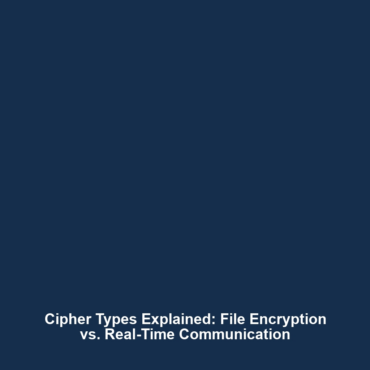Use Cases for Each Cipher Type in Cryptography
Introduction
Cryptography is a crucial technology that ensures the confidentiality, integrity, and authenticity of data. Among its various applications, the use cases for each cipher type—specifically file encryption and real-time communication—play a pivotal role in protecting sensitive information. In a world increasingly reliant on digital communication, understanding these use cases is vital. This article explores the significance of both file encryption and real-time communication within the broader context of cryptography, providing insights into their unique functionalities and applications.
Key Concepts
File Encryption
File encryption involves encoding data at rest, ensuring that unauthorized users cannot access sensitive files. This technique utilizes symmetric or asymmetric ciphers to secure information stored on devices. Major principles include the encryption algorithm, key management, and the type of encryption (symmetric or asymmetric). Keywords related to cryptography emphasize the importance of these factors in determining the effectiveness of file encryption.
Real-Time Communication
Real-time communication, on the other hand, refers to the encryption of data in motion, enabling secure exchanges of information over the internet. Protocols such as SSL/TLS for web traffic or end-to-end encryption in messaging apps exemplify this use case. Key principles include latency, encryption speed, and the need for continuous data stream protection, which are crucial for maintaining real-time interaction security.
Applications and Real-World Uses
The real-world applications of file encryption and real-time communication are vast, illustrating their significance in the field of cryptography:
- File Encryption: Widely used in cloud storage services to protect user data from unauthorized access.
- Real-Time Communication: Essential in platforms like WhatsApp and Signal, where end-to-end encryption safeguards conversations from eavesdropping.
Understanding how these types of ciphers are used in various sectors, such as finance and healthcare, underscores their impact on ensuring data security and privacy.
Current Challenges
Despite their importance, there are notable challenges in studying and applying use cases for file encryption and real-time communication:
- Need for user-friendly encryption tools that balance security and usability.
- Vulnerability to attacks, including man-in-the-middle and brute force.
- Compliance with regulatory standards while ensuring robust encryption.
These issues highlight the complexities involved in effectively implementing cryptographic solutions.
Future Research and Innovations
Emerging technologies and research are poised to transform the landscape of both file encryption and real-time communication. Innovations such as quantum cryptography and homomorphic encryption are at the forefront, promising enhanced security protocols that could redefine how data is protected in the future. The potential for integrating artificial intelligence in cryptographic processes also presents exciting possibilities for developing next-gen security solutions.
Conclusion
In conclusion, understanding the use cases for each cipher type, whether for file encryption or real-time communication, is essential in the evolving realm of cryptography. These applications not only enhance data protection but also pave the way for innovations in secure digital communication. For further reading on related cryptographic techniques and advancements, explore our related articles section.


